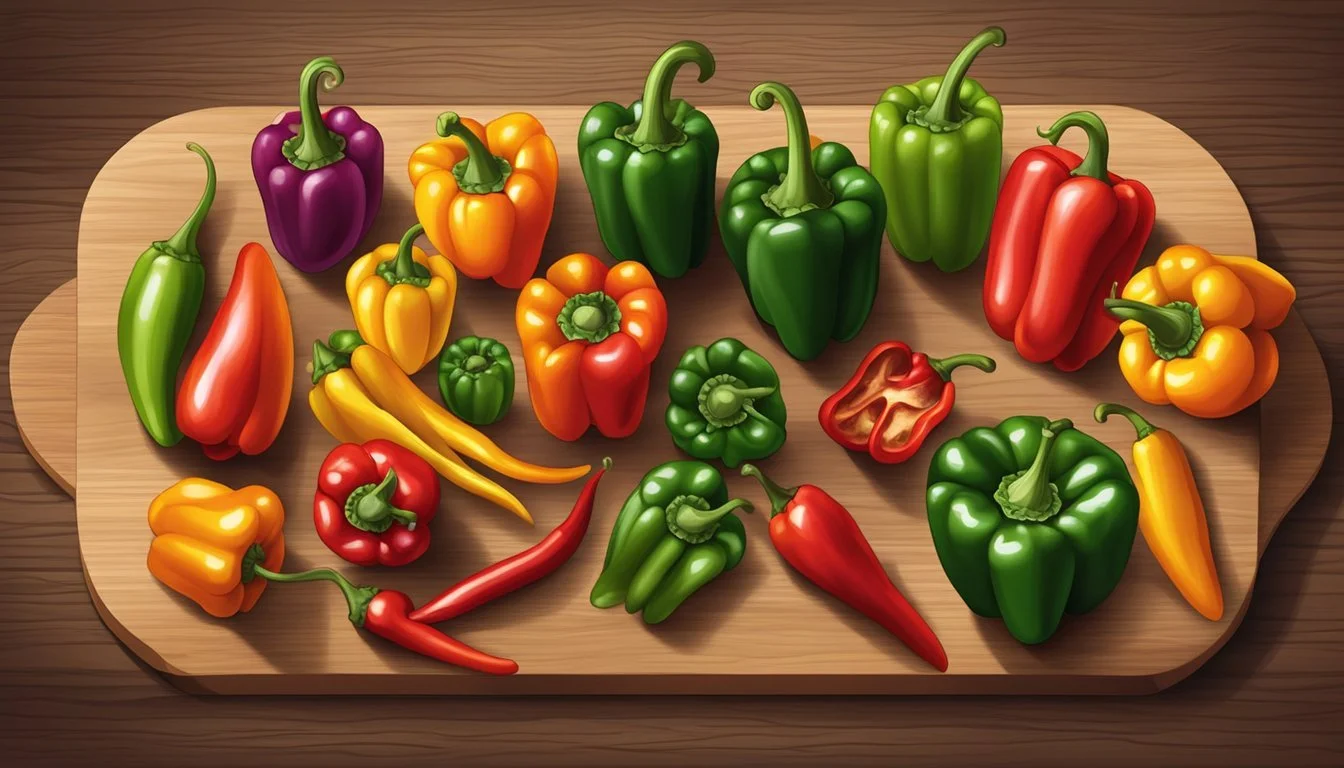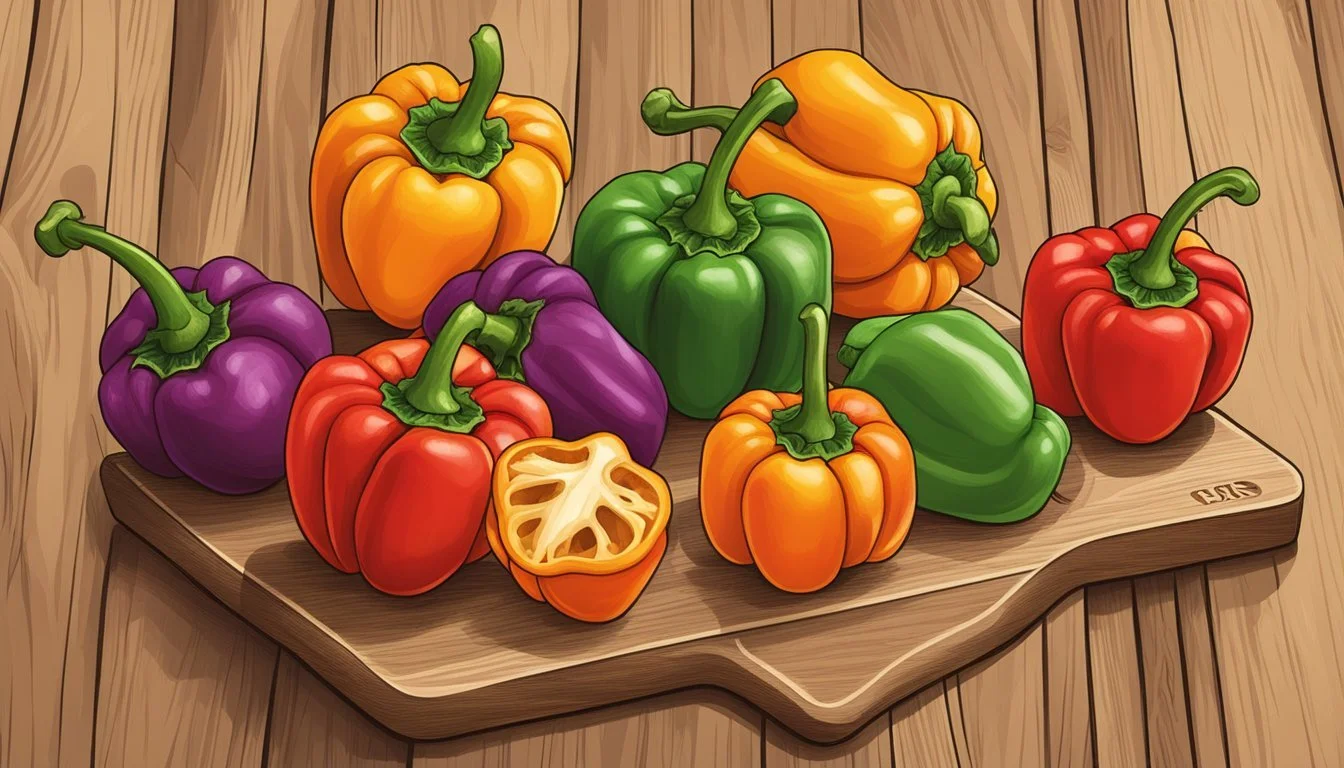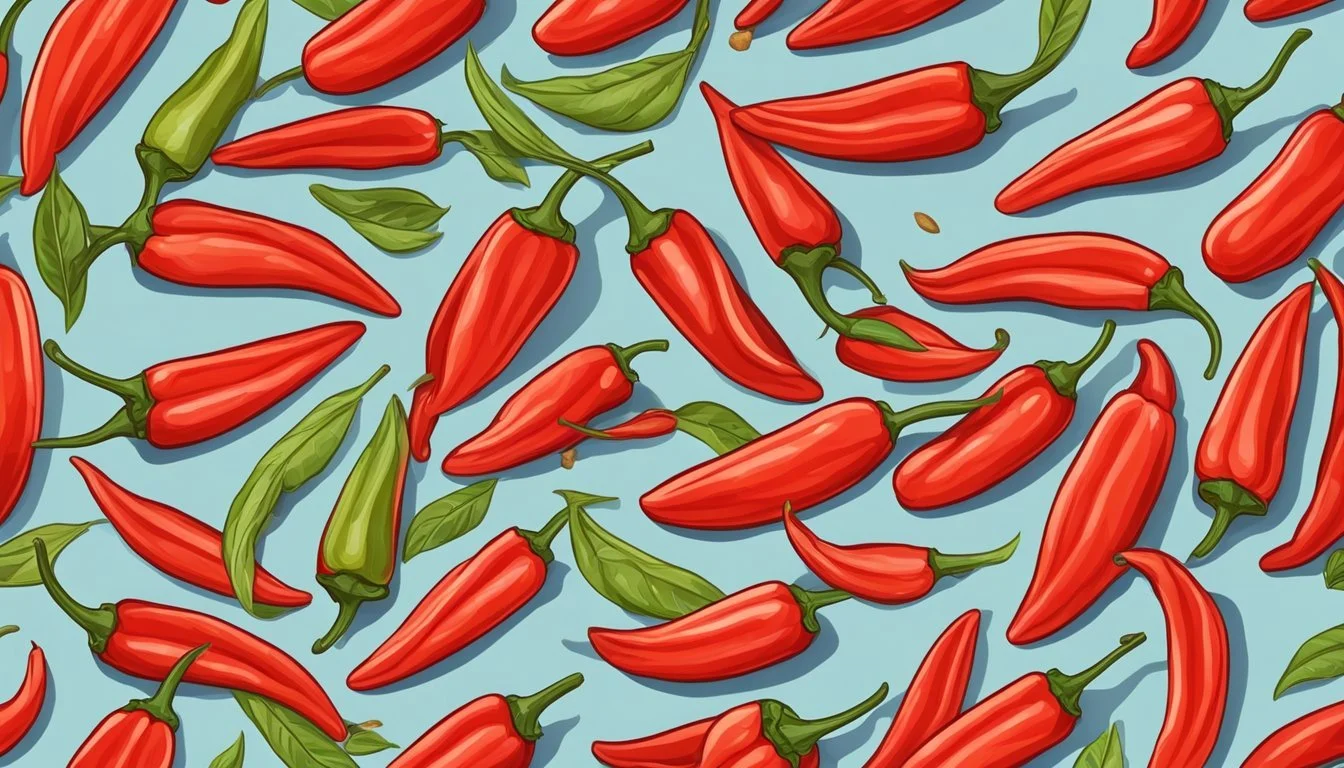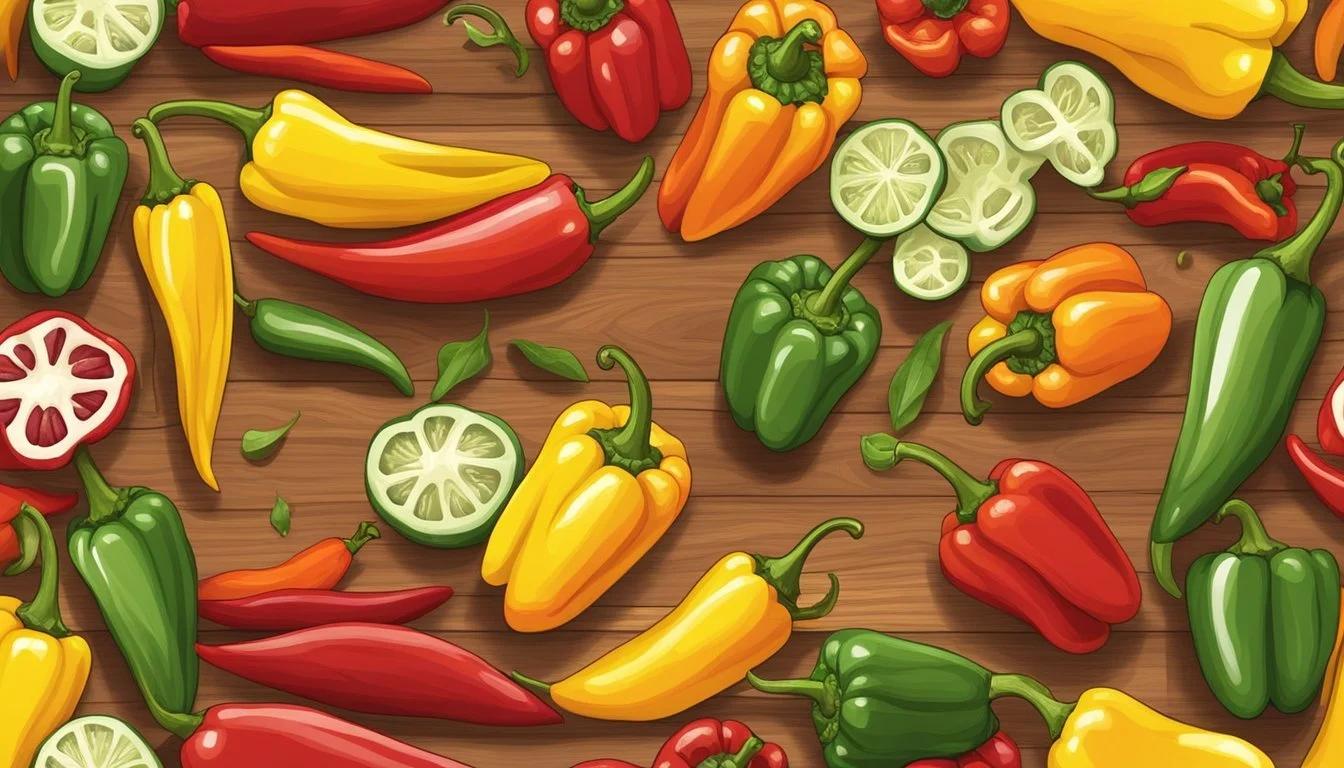10 Peppers Every Spice Lover Needs to Eat at Least Once
A Flavorful Journey
Peppers are a cornerstone of culinary traditions across the globe, adding vibrant flavors and varying degrees of heat to dishes. From the mild sweetness of bell peppers to the intense spiciness of the Carolina Reaper, these versatile fruits offer a wide range of experiences for spice enthusiasts.
Exploring different types of peppers can elevate your culinary skills and enhance the flavors of your meals. This article will introduce you to ten peppers that every spice lover should try at least once, providing a diverse palette of tastes to enjoy.
1) Carolina Reaper
The Carolina Reaper is renowned for its intense heat. Developed by "Smokin" Ed Currie in South Carolina, it held the title of the hottest chili pepper in the world until 2023. It measures an average of 1,641,183 Scoville Heat Units (SHU), with peaks reaching over 2.2 million SHU.
This pepper has a distinctive, wrinkled, and bulbous shape, ending with a thin, pointy tail. The name "Reaper" was inspired by this tail's resemblance to the scythe of Death. The most common color is red, but variations like peach and purple also exist.
Cooking with Carolina Reapers offers various methods. Peppers can be dehydrated, fermented, canned, or frozen. On the grill, they develop a smoky flavor if smoked for 1-2 hours. It's important to handle these peppers carefully to avoid burns.
Carolina Reaper's intense heat is often balanced by a surprisingly fruity flavor. It pairs well with ingredients that can complement its fierceness and offer some sweetness, such as fruits and sweet vegetables. This combination elevates dishes by adding depth and complexity to the palate.
2) Ghost Pepper
The Ghost Pepper, also known as Bhut Jolokia, is one of the most renowned peppers in the world of spice enthusiasts. Native to India, this pepper once held the title of the world's hottest chili.
With a Scoville rating ranging from 855,000 to over 1,000,000 SHU, Ghost Peppers are extremely hot. They bring intense heat that can be a challenge even for seasoned spice lovers.
In culinary uses, Ghost Peppers are often used in sauces, marinades, and sometimes in fresh form. Their heat is accompanied by a distinctive, slightly fruity flavor, making them prized in both Indian and international cuisine.
Cooking with Ghost Peppers requires caution due to their potent heat. It's recommended to use gloves when handling them to avoid skin irritation. Even a small amount can significantly increase the spiciness of a dish.
Ghost Peppers are also popular in the creation of hot sauces and spicy snacks. These products often come with warnings due to the pepper's intense heat.
Eating a Ghost Pepper can be an exhilarating experience. However, it’s not for the faint-hearted, as the extreme heat can cause discomfort and should be approached with care.
3) Habanero
Habanero peppers rank high in spice, often reaching between 100,000 and 350,000 Scoville Heat Units (SHU). This makes them much hotter than most commonly used peppers.
Known for their distinct fruity flavor, habaneros can add depth to dishes like salsas, hot sauces, and marinades. The pepper's unique taste complements its intense heat, enhancing various recipes.
When handling habaneros, it's crucial to wear gloves and avoid touching your face. Capsaicin, the chemical responsible for their spiciness, can cause irritation if it comes into contact with skin or eyes. Always wash your hands thoroughly after handling.
4) Scotch Bonnet
The Scotch Bonnet is a small and potent chili pepper with a heat range of 100,000 to 350,000 Scoville Heat Units. It is closely related to the Habanero but carries its own unique characteristics. Its name comes from its resemblance to a tam o' shanter, a traditional Scottish cap.
Its flavor profile is both sweet and fruity, adding a distinctive taste to dishes. This makes it a staple in Caribbean cuisine, often found in jerk seasoning, stews, and pepper sauces. The Scotch Bonnet’s vibrant colors, ranging from red and yellow to brown, also add visual appeal to meals.
Despite its intense heat, the Scotch Bonnet is popular for pepper eating contests and as an ingredient for those who enjoy a higher spice level. Due to its potency, it’s advised to handle the pepper with gloves and to use it sparingly in recipes.
5) Piri Piri
Piri Piri, also known as Peri-Peri or Pili Pili, is a small but fiery chili pepper cherished in Portuguese and African cuisines.
The name "Piri Piri" comes from the Swahili term meaning "pepper pepper." These chilies belong to the Capsicum frutescens species and pack a notable punch.
With a Scoville Heat Unit (SHU) range of 50,000 to 100,000, Piri Piri peppers sit between cayenne and habanero on the heat scale. They provide an intense spiciness that enhances various dishes.
Piri Piri peppers are often used to create flavorful sauces. A popular preparation involves blending the peppers with oil, garlic, lemon, and salt.
This pepper sauce serves as a superb marinade or basting sauce for meats, especially chicken. The combination of heat, tang, and seasoning renders a unique taste experience.
In addition to sauces, Piri Piri peppers can be used to spice up soups, stews, and grilled dishes. Their versatility and bold flavor profile make them a must-try for spice enthusiasts.
6) Jalapeño
Jalapeño peppers are a popular choice among spice lovers. They offer a moderate heat with a Scoville rating between 2,500 and 8,000 SHU, making them versatile for various dishes.
Their heat can vary based on where they were grown and their specific variety. TAM II, a milder variant, has become more common, leading to jalapeños that aren't as spicy.
Jalapeños can be used fresh in salads and salsas or cooked into soups and stews. Dried jalapeño flakes are also available, easy to store, and perfect for adding heat to meals when fresh peppers aren't accessible.
For those who enjoy experimenting with flavors, jalapeños offer a bright and fiery bite. They pair well with dishes that require a moderate spice level without overwhelming the palate.
7) Serrano
Serrano peppers are a type of chili pepper originating from the mountainous areas of Puebla and Hidalgo in Mexico. The name 'serrano' comes from the Spanish word for mountains, 'sierras'.
These peppers are small but pack a considerable heat, ranging from 10,000 to 23,000 Scoville Heat Units. This places them between the jalapeño and cayenne pepper in terms of spiciness.
Despite their heat, serrano peppers offer a bright, crisp flavor that enhances many dishes. They are commonly used in Mexican cuisine, adding a kick to salsas, sauces, and even pickled recipes.
Their thin skin makes them easy to cook with, requiring no peeling or extensive preparation. Cooks can simply chop them up and add them to dishes for an instant flavor boost.
Serrano peppers are also versatile and can be used both raw and cooked. They retain their flavor and heat well, making them ideal for grilling, roasting, or frying.
For those who love spice, serrano peppers are a must-try. Their unique blend of heat and flavor brings an exciting dimension to a variety of culinary creations.
8) Thai Chili
Thai chilis are small but pack a robust punch of heat. They are a staple in Thai cuisine, offering both color and spice to dishes.
One commonly used variety is the Prik Chee Fah, which can be found in red or green. These peppers add a noticeable kick and are often used in stir-fries and salads.
Another well-known variety is the Prik Mun, a dark green pepper primarily used for pickling. It offers a milder spice compared to its counterparts.
The Prik Noom is a light green chili with more spice. Its versatility makes it suitable for numerous dishes, including soups and sauces.
Prik Jinda is a spicy red or green pepper. It has a fresh, earthy flavor and a higher heat level, ideal for curry pastes.
Originating from South America, Thai chilis thrive in Thailand's warm climate. Their Scoville heat units (SHU) can range from mild to a fiery intensity.
Each Thai chili variety brings a unique flavor and heat level, enhancing the culinary experience. Spice enthusiasts must try these peppers to truly appreciate their complexity and depth.
9) Tabasco Pepper
The tabasco pepper stands out for its distinctive juiciness and medium heat, ranging from 30,000 to 50,000 Scoville heat units (SHU). Known for its use in the famous Tabasco sauce, this pepper brings a bright, tangy flavor to various culinary dishes.
Fresh tabasco peppers grow upright on the plant and mature to a vibrant red. When selecting tabasco peppers, look for those that are firm and free from blemishes. Ripe peppers will yield the best flavor.
In cooking, tabasco peppers can be used fresh or fermented for a deeper taste. To ferment, place the peppers in a salt brine and store them in a cool, dark place for several weeks. This process enhances their flavor profile.
These peppers, low in calories, are primarily composed of water and carbohydrates. They also provide a good source of vitamins and minerals, contributing to a healthy diet. When handling these peppers, be mindful of their heat to avoid irritation.
Whether used in hot sauces, pickled, or fresh, tabasco peppers add a unique heat and tang to dishes, making them a versatile ingredient for spice lovers.
10) Cayenne Pepper
Cayenne pepper, known for its vibrant red color and fiery heat, is a staple in many spice enthusiasts' kitchens. A popular addition to many dishes, it can enhance the flavor profile with its distinct heat.
This pepper scores 30,000 to 50,000 Scoville Heat Units (SHU), placing it in the mid-range of the spiciness scale. This makes it versatile enough to add a punch without overwhelming other flavors.
Nutrition-wise, cayenne pepper is a powerhouse. It contains significant amounts of Vitamin C, Vitamin A, and Vitamin B6. These nutrients can contribute to a healthy diet.
Research suggests consuming 2 to 9 milligrams of cayenne pepper daily is safe. It may even aid in slight abdominal fat loss. Fresh cayenne peppers are preferable, as they contain more vitamins.
Cayenne pepper is often used in powdered form. It's great for spicing up soups, stews, and even marinades. Despite its heat, it has a slightly smoky flavor that can complement various dishes.
For spice lovers, cayenne pepper is a must-try. Its health benefits, combined with its unique flavor, make it a valuable addition to any spicy dish.
Health Benefits and Nutritional Value of Peppers
Peppers offer a rich profile of vitamins, minerals, and antioxidants, contributing significantly to overall health and well-being. Their nutritional value makes them a versatile and beneficial addition to any diet.
Rich in Vitamins and Minerals
Peppers are loaded with essential vitamins and minerals. They contain vitamin C, which is vital for immune function and wound healing. For instance, chili peppers have high vitamin C content, enhancing their antioxidant capabilities.
Vitamin B6 is also present in peppers and plays a crucial role in energy metabolism and brain health. Moreover, peppers provide potassium, which helps regulate blood pressure, along with vitamin A, which is important for vision and skin health.
The dietary fiber in bell peppers promotes digestive health by adding bulk to stool. A one-cup serving of raw bell peppers provides about 2.5 grams of fiber.
Antioxidant Properties
Peppers contain various antioxidants that protect the body from oxidative damage. These include vitamins C and E, along with beta carotene, which converts to vitamin A in the body. Antioxidants are essential for combating free radicals, which can cause cellular damage.
Certain compounds in chili peppers, such as capsaicin, are known for their anti-inflammatory properties. Capsaicin not only adds spice but also benefits cardiovascular health by improving blood flow and reducing bad cholesterol levels.
Flavonoids in peppers further contribute to their antioxidant profile, assisting in reducing the risk of chronic diseases. The combination of these antioxidants supports overall health by safeguarding the body’s cells and boosting the immune system.
How to Store and Preserve Peppers
Proper storage and preservation of peppers ensure they remain fresh and flavorful for longer periods. These methods help maintain their taste, texture, and nutritional value.
Refrigeration Techniques
Whole peppers can last 10 to 14 days in the refrigerator. To maximize their shelf life, store them in a perforated bag. This can be done easily by poking holes in a plastic bag or purchasing pre-made ones. These bags help maintain the right humidity levels.
If the peppers are cut, they should be used within 4 to 5 days. Place the cut pieces in an airtight container with a paper towel to absorb excess moisture. Avoid placing peppers in the refrigerator door as the constant temperature changes can reduce their freshness.
Drying and Freezing Methods
Freezing is one of the simplest ways to preserve peppers. After washing and drying them, cut the peppers into chunks, remove stems and seeds, and then space them out on a cookie sheet for flash-freezing. After about 15-30 minutes, transfer the frozen pieces into airtight bags or containers.
Drying peppers can be accomplished using an electric dehydrator or by air-drying. When using a dehydrator, set it to about 125°F (52°C) and let them dry for 8-12 hours until completely brittle. Air-drying can be done by hanging them in a dry, well-ventilated area. Ensure the peppers are evenly spaced and not touching each other.
Cooking Tips and Recipes
When cooking with peppers, their unique flavors and heat levels can elevate any dish, from daily meals to special sauces. Here are some ways to seamlessly integrate peppers into your culinary repertoire and craft spicy sauces that'll tantalize your taste buds.
Incorporating Peppers in Daily Meals
Peppers can be used in various meals to add depth and spice. Jalapenos are perfect for adding heat to nachos or sandwiches. Simply slice them thin and scatter over the dish. Bell peppers are versatile; sauté them with onions as a base for stir-fries or add them to fajitas.
Paprika can be sprinkled over eggs or mixed into stews and soups to impart a mild, smoky flavor. Cayenne pepper, typically found in powdered form, is excellent for seasoning proteins like chicken or tofu. A half teaspoon can transform a bland dish into something vibrant.
For habaneros, use caution due to their intense heat. Incorporate small amounts into salsas or marinades for a fiery kick.
Spicy Pepper Sauces
Creating sauces with peppers can be simple yet transformative for your dishes. Chili pepper sauces often start with basic ingredients like tomatoes, garlic, and onions. Adding serranos or jalapenos to the mix can significantly enhance the flavor profile.
*Habanero sauces are known for their intense heat. Blend habaneros with mango or pineapple for a sweet and spicy condiment. This is perfect for drizzling over grilled meats or adding to tacos.
Chipotle peppers in adobo sauce can serve as a base for barbecue sauces. Puree them with ketchup, vinegar, and brown sugar for a smoky, spicy condiment.
Experimenting with different peppers and combinations can lead to discovering new favorite recipes and flavors.











